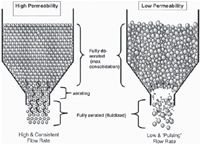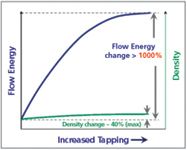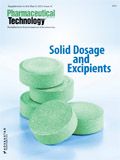Powder Testing Techniques for Tablet Manufacture
This article considers the different conditions to which the powder is subjected in the tableting process, and discusses which powder properties should be measured to accurately reflect likely powder behavior in the process.
In tablets, the active pharmaceutical ingredient (API) is often only a tiny proportion of the finished product. The steps that precede the tablet press are designed to incorporate the API within a blend that processes efficiently to produce tablets of the required quality. Excipients include fillers, as well as components that play a more active role in processing, such as glidants to improve powder flow and lubricants that reduce ejection force and prevent adherence to the press.
These raw ingredients may be screened, granulated, dried, milled, classified and blended, often in a number of steps, to produce feed for the tablet press. Batch processing, in which a defined amount of material is processed and then tested to confirm its suitability for the next step, is common.
Each ingredient and unit operation is a potential source of variability arising from any number of factors including:
- Raw materials
- Human intervention (especially if the plant is manually controlled)
- Sampling and analytical test method variability
- Environmental influences
- Process equipment capabilities and calibration limits (1).
Materials are tested after each processing step with the aim of quantifying variability, which raises the question of how to characterize "in-process" materials to ensure success. Because the tablet press is at the end of the line, any sources of variability along the way will tend to act cumulatively at the tablet press.
Effective management of variability relies first on being able to detect a problem. This means that a specification used to define acceptability—in a feed or after a processing step— must reliably identify a material that will fail to process as required in a subsequent step or that will go on to produce a substandard product. Such specifications must be based on properties that closely correlate with the aspects of performance that are critical to success. This approach relies on identifying and measuring powder properties that have a defining influence on the efficiency of the operation and the quality of the final product.
Analyzing the tableting process
Powder behavior is influenced by an array of different variables, including primary parameters such as particle size and shape, as well as system factors such as extent of consolidation and aeration. This complexity makes it difficult to predict behavior. To develop a secure basis for process optimization, it is necessary to select powder property characterization techniques that simulate the process environment, because it is difficult to reliably infer performance from test data acquired under conditions that are not representative of those applied during processing.
Manufacturing tablets from a blend tends to be a single integrated process. However, closer analysis reveals four distinct stages, particularly in terms of the conditions applied to the powder. These are:
- Discharge from the feed hopper
- Flow into and through the feed frame
- Die filling
- Compression, followed by ejection.
Hopper discharge. Tablet manufacture begins with discharge of the blend from the hopper, ideally at a consistent, controlled flow rate. Material flows under gravity, at relatively low flow rates, into the feed frame. In the hopper itself, moderate stress is imposed by the weight of the stored powder. The resulting consolidation may inhibit flow, either because of interactions between the vessel and powder or as the result of powder-powder interactions. Shear strength and wall friction are therefore highly relevant powder properties.
Feed frame flow. The hopper discharge is routed to the feed frame via enclosed pipe work that provides containment. The ease with which the blend flows under gravity is important here, but so too is the permeability of the powder (2). A blend with low permeability that resists the backflow of air necessary for smooth flow will tend to pulse or 'slug' into the feed frame (see Figure 1). This can result in erratic pressure that varies at a relatively high frequency. The tablet press weight control system cannot adequately compensate, which results in variable tablet weight. In contrast, more permeable blends tend to exhibit more consistent flow, ultimately delivering a more uniform density to the feed frame and a more consistent final product.

Figure 1: More permeable powders tend to flow consistently from a hopper, while those that are less permeable can give rise to a low rate, ’pulsing’ flow that is detrimental to process efficiency and product quality.
Die filling. From the feed frame, powder is swept into the dies to ensure a complete fill. Here the blend is moderately to loosely packed, but sheared at relatively high speeds as the paddles of the frame rotate. Agglomeration and attrition are both potential problems, exacerbated by the need to recycle powder around this part of the process. Both can lead to segregation of the blend, giving rise to non-uniformity in the finished tablet. Attrition additionally gives rise to dusting, creating fines that can compromise processing efficiency and the properties of the finished tablet.
In the feed frame, the powder flows under gravity but, depending on the design of the paddles, there may also be a significant element of "forced flow." Angling the sweeping paddles can help to force the powder down into the dies to improve filling efficiency. While optimizing the flow regime in the feed frame improves consistency and the rate of die filling, doing so relies on understanding how the powder flows under different conditions and, in particular, the material's response to forcing conditions.
In addition, the response of the powder to air is critical for consistent die filling. A permeable blend that quickly releases entrained air will settle rapidly and efficiently fill the die. Simultaneously, air can provide lubrication and promote flow in the feed frame. Therefore, a material that releases air too easily may not flow consistently. Understanding exactly how the powder responds to air can be critical in optimizing die filling.
Compression. During the final compression step, the powder plug is subject to high stress. Here, the compressibility of the powder is relevant because it quantifies how the movement of the punches will impact the powder. In addition, adhesivity indicates how likely it is that material will stick to the tablet press tooling.
Choosing the best powder characterization techniques
Successful processing requires a powder that is compatible with all stages of the process. Because it is important to understand how the powder will behave under many different conditions, applying a single powder testing technique may not give adequate information. Historically, the pharmaceutical industry has relied on parameters such as Hausner Ratio and Carr's Index, which are both derived from tapped density techniques. More recently, the industry has begun to use shear testing.
These approaches do have some relevance when trying to access information to support optimization of the press. Shear testing, for example, was developed, and remains widely used, for the design and troubleshooting of hoppers. This test provides valuable shear strength data that is relevant to design and operation of the feed hopper and to the compression stage, in which applied stresses are even higher. However, shear testing may not be the best technique for generating data to support other parts of the tablet manufacturing process, in which applied stresses are far lower.
For example, the shear data presented in Figure 2a for vanillin and ethylvanillin classifies them as closely similar. However, as shown in Figure 2b, the dynamic flow energy measurements tell a different story, suggesting that the materials can behave differently in certain circumstances. Flow energies are generated by measuring the axial and rotational forces acting on a paddle as it rotates through a powder sample (3). Downward rotation of the paddle imposes a forcing, bulldozing action while an upward traverse measures a flow energy more closely associated with gravity induced flow. The data suggests that while these two materials may behave similarly in the hopper, and in terms of how they cohere in the finished tablet, they will behave very differently in the feed frame. The ease with which the materials flow into the feed frame, and subsequently into the die, as well as their response to a range of blade designs, are all likely to be different.

Figure 2: Shear data classifies these two excipients as closely similar while flow energy measurements show that in certain circumstances they can behave quite differently.
Similarly, tapped density measurements can differ from flow energy measurements. Although tapped density measurements do detect changes that indicate differences in powder properties, they are far less sensitive than dynamic techniques in specifically measuring flow properties (see Figure 3). Variability in a material, which could go on to impact flow behaviour in the tablet press, might be undetected by tapped density measurements.

Figure 3: For this system, tapped density data are less sensitive than flow energy measurements in detecting changes in powder flowability.
Looking across the tablet-making process in its entirety highlights the properties that could be measured to optimize performance at each step. These include:
- Shear properties—for the design, operation, and troubleshooting of hoppers
- Bulk properties such as permeability and compressibility—to assess the response of the powder to air, the ease with which displaced air will be dispersed, and how the blend will be impacted by compression
- Dynamic properties that directly quantify flowability under different conditions—for optimizing flow through the feed frame, assessing the impact of different paddle designs, investigating the effect of air on powder flowability, and quantifying de-aeration behaviour.
Dynamic testing can also be used to assess powder stability and is therefore a useful tool for investigating the likelihood of attrition, segregation, and/or agglomeration.
Together these measurements form a database of properties that can be used to tightly define an optimal blend specification. Furthermore, such data would support investigation into which parameters in upstream processes ultimately dictate performance in the press and the quality of the final product. Such strategies are highly beneficial in pushing towards more efficient manufacture on the basis of secure knowledge.
Conclusion
Within the pharmaceutical industry there is increasing emphasis on processing efficiency and more effectively controlled manufacture. In production, it is impossible to eliminate all the possible sources of variability, but it is feasible to compensate for them and control their impact. This relies on identifying, measuring, and controlling those parameters that define processing efficiency and the quality of the finished product.
In solid-dosage manufacture, achieving this goal requires a relevant and sensitive powder testing toolkit capable of reliably generating parameters that can be directly correlated with process performance. Key to this is the ability of a technique to effectively simulate the specific processing environment, which, as an analysis of tableting reveals, can vary considerably. Instruments that combine established techniques, such as shear and bulk property testing, with newer methodologies, such as dynamic testing, can be valuable. The user can then tailor testing to the specific application, and access the most complete information for process design, optimization, and control.
Tim Freeman* is managing director and Jamie Clayton is operations manager at Freeman Technology, 1 Miller Court, Severn Drive, Tewkesbury, Gloucestershire, GL20 8DN, United Kingdom, tel. +44(0)1684.851.551, fax. +44(0)1684.851.552, info@freemantech.co.uk, www.freemantech.co.uk
*To whom all correspondence should be addressed.
References
1. M. Glodek et al., "Process Robustness: PQRI White Paper," online, www.pqri.org, Oct., 2005.
2. G. Carlson and B. Hancock, AAPS Annual Meeting and Exposition (Atlanta, GA, 2008).
3. R. Freeman, Powder Technol. 174 (1–2) 25-33 (2007).

Pharmaceutical Tariffs Are Imminent: How Industry is Bracing for Impact
April 16th 2025On April 14, 2025, the Trump Administration launched a national security-driven investigation into pharmaceuticals, a move that will likely result in tariffs being placed on pharmaceutical drugs, ingredients, and other components that are imported from outside of the United States.
Drug Solutions Podcast: A Closer Look at mRNA in Oncology and Vaccines
April 30th 2024In this episode fo the Drug Solutions Podcast, etherna’s vice-president of Technology and Innovation, Stefaan De Koker, discusses the merits and challenges of using mRNA as the foundation for therapeutics in oncology as well as for vaccines.